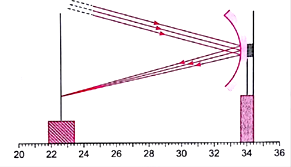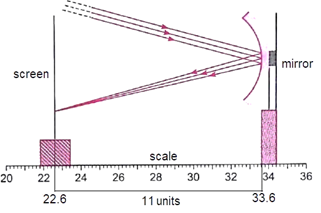Find the focal length of the concave mirror in the experimental set-up shown in figure.

OR
In an experiment to trace the path of a ray of light passing through a rectangular glass slab, the angle of incidence in the air was given as 60°. Two students P and Q found the angle of refraction as 42° and 65° respectively. Who is right and why?

The experimental setup is used to determine the focal length of a concave mirror. The focal length is just the distance between the mirror and the point where all the parallel rays meet after reflection. So, the calculations are,
f (focal length) = (mark at which is mirror is placed) – (mark at which is screen is placed) {as shown in the diagram}
f= 33.6 – 22.6 = 11 units.
So, the focal length of the given spherical mirror is 11 units.
OR
If we compare air and glass, air is optically rarer medium. And we know that, when a ray of light enters an optically denser medium from an optically rarer medium, light ray bends towards the normal.
Here, the angle of incidence = 60°
The light ray will bend towards normal, and hence, the angle of refraction will be less than the angle of incidence.
The angle of incidence > angle of refraction.
Therefore, the angle of refraction could be 42°and not 65°.
Hence, reading recorded by student P is correct.